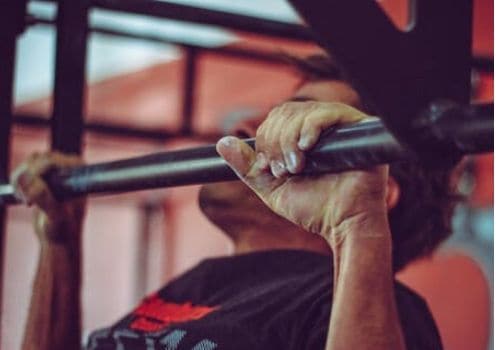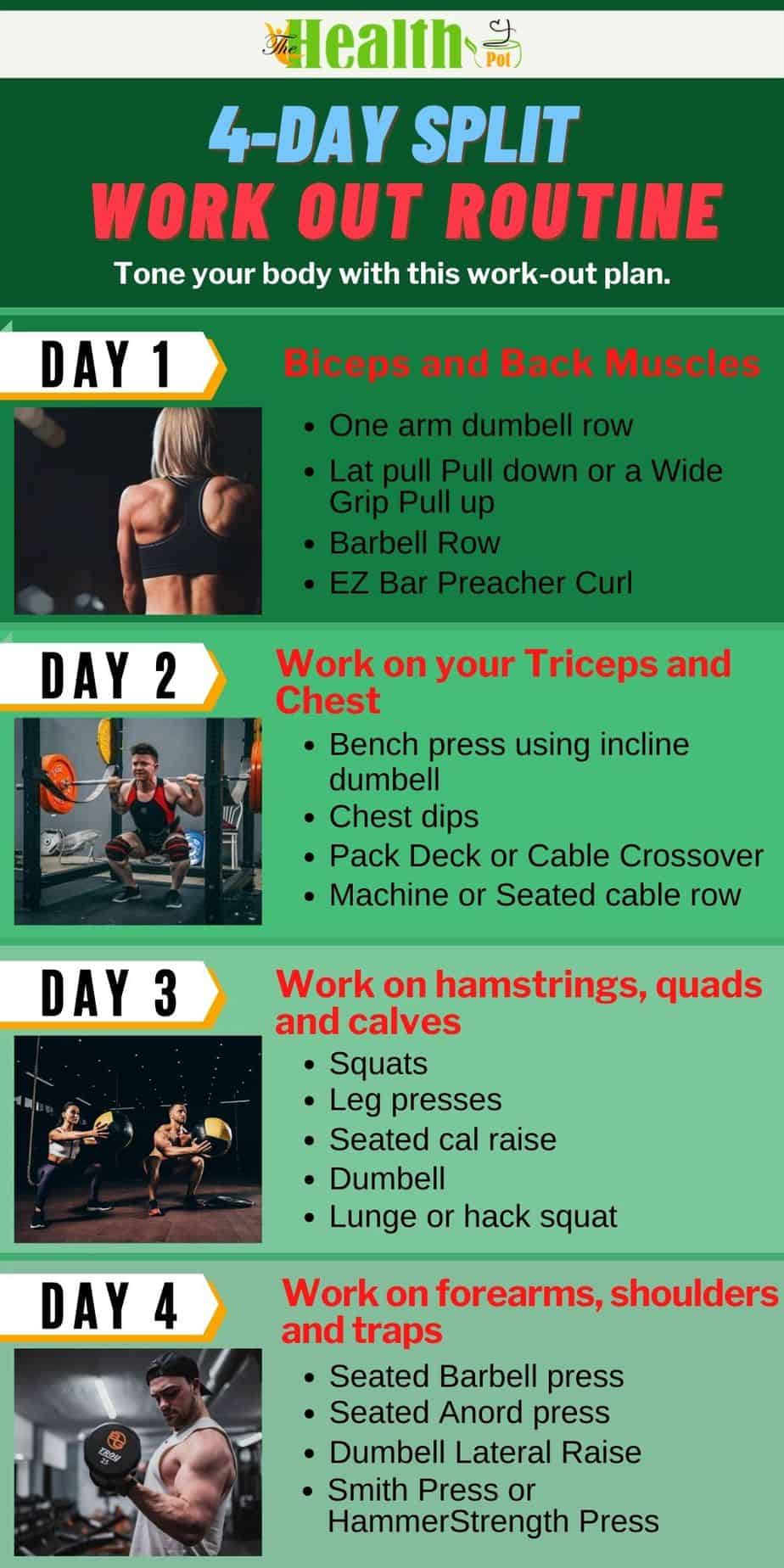When working out, strength and muscle building should always go hand in hand. You can never grow your core strength without growing your muscles. On the other hand, muscle growth goes hand in hand with strength. However, achieving both requires a different set of exercises for each.
In this article we look at the best 4-day split workouts to help you gain strength and build muscles. One of the terms you’ll come across in this article is ‘hypertrophy.’ This is the increase in the size of the tissue through the enlargements of the cells that make the muscle bundle.
Any program that results in muscular growth can be called a hypertrophy program. While at it, performance and strength-building training can also be incorporated in the program so that you meet the three goals at once.
Enter the 4-day split training…
What Is the 4-Day Split Workout Program?
If you work out continuously for a week without a break, you will be suffer from fatigue, sore muscles, and low performance. Also. you’ll likely not work out all the large sets of muscles in your body and fail to achieve full-body muscle training.

That’s why fitness experts recommend that you include rests in your exercise program so that your body can recuperate and meet your goals. It also provides a psychological break from repetitive exercises every other day.
The four-day split workout training program allows for the traditional three-day training program, which is divided and spread across the week. A popular approach used in this case is to work out the upper body muscles for two days and the lower part of the body for another two days.
Why 4 Days and Not Any Other Number of Days?
You go for a 4-day workout plan to build muscle, and then strength and performance will join later. Therefore, the principle that takes precedence in the entire training process is weight training. Weight training, in turn, is determined by the intensity of your sets.
The intensity is the amount of tension that you will subject your muscles in a training session. You can only achieve high-level training if you train each group of muscles once a week while ensuring that each exercise is high intensity.
With a four-day training schedule, you can work each large group of muscles in each training session. Since you will be doing it once a week, the muscles have enough time to heal and grow to prepare for the next session.
Growth and healing are essential components of any successful training program. On the other hand, rest is an integral part of muscle growth. Failure to incorporate it into your program often leads to overtraining.
People who overtrain reach their plateau quite fast and start regressing in both the growth of the muscle and training. Some athletes build in some accessories or conditioning after they have completed the main lifts. This way, they can achieve greater muscle mass and well-conditioned body.
Types of Split Routines

Muscle Group Training
This is the most popular type of workout where each session focuses on a particular group or several groups of muscles. This article will look at this type in detail.
Power/ Hypertrophy Training
In this type of weight training, trainees focus on either high rep or low-intensity movements (for hypertrophy), or high-intensity movements with a lower rep (to gain power).
Upper/Lower Training
This type of split training is similar to the body part training. However, in this case, the focus of the trainee is the location of the muscle groups. You may start with upper body muscles and then work the lower body muscles, or vice versa. This is a perfect 4-day split workout for beginner trainees.
PPL Routine
The workout plan focuses on the exercise types rather than the muscle groups that you are targeting. For example, squats for abs and lunges for your legs, push exercises such as overhead press and bench press, and pull exercises such as barbell rows and deadlift.
Full Body Workout
A 4-day full body workout is the same as workouts targeting specific body muscles. However, in this case, you will be working out the entire body by touching all the major muscles. Your rest days and schedule should be the same. This workout is ideal for people who have fast rates of recovery, since it is quite straining.
Variations in the Four-Day Workout Plan
There are many ways you can utilize the four days of training and still get your result. Your choice largely depends on your fitness level and other factors, such as core strength and susceptibility to fatigue. Here are some of the most popular scenarios.

4 days on, 3 days off
This method involves training for four consecutive days and resting for three days of the week, then repeating the cycle. Some people may think that they risk overtraining by going to the gym four days in a row.
However, since you are training different muscle groups, the muscles that you started working out have a chance to rest until the next session the following week. Most experienced athletes pick this 4-day workout to get ripped fast.
The three rest days does not mean that you will not be doing any exercise. Instead, you will not be doing any exercises that are targeting specific muscle groups that you had trained earlier.
We recommend that you consider doing cardiovascular exercises, such as playing basketball and football, swimming, taking walks, or light jogging. It is also not bad to do a little weight lifts so that your muscles stay active all week.
Regular activity gets rid of the need for long warm-up when you are doing more intense workouts.
2 days on, 1 day off, 2 days on, 2 days off
Most bodybuilders believe that this is the best variation for their four-day routine as it incorporates rest amid regular intensity training.
However, the main advantage of taking up this routine is that the resting period allows you to gain strength and deal with muscle fatigue so that you can perform better in your next training session.

We recommend that those starting intense workouts consider this routine before going for more intense ones, like the one discussed in the section above.
There are average hobbyist bodybuilders who go for a more relaxed routine by picking any four days within the week. While the routine may work, you may be required to train consecutive days in certain weeks.
Besides, it calls for discipline to ensure that you train for four days a week. Most beginners have to run on a strict routine for them to meet the requirements. On the other hand, training in a low rep can cause fatigue.
That is why, we recommend that you do at least three sets per exercise. On the other hand, a high rep range may cause your form to suffer, or you will be forced to decrease your amount of weight.
Unfortunately, with poor form, you won’t achieve progressive overload training. To illustrate: You can track your gains with ease when doing 4 to 6 reps as opposed to when you are doing 14 to 16.
Also, high-intensity exercise leads to muscle growth more rapidly than high volume exercises. Therefore, if you decrease the amount of weight, you will slow your muscle growth.
A Sample Classic 4-Day Weight Lifting Workout Split
Before getting started, remember that you will have heavy compound exercises over extended periods with short rests between each session. This is important to boost your muscle’s progress.

Here is how the program looks like:
- Days of the week – 4
- Workout duration per session – 60 minutes
- Number of sets per exercise – 3
- Rep Range – 4 to 6 minutes
- Rest Intervals between sets – 2 to 3 minutes
- Duration of the Program – 8 weeks
Type of equipment required – Dumbbells, bodyweight, barbells, and sissy squat machine.
In the program below, we are going to follow the second variation of having two days on, a day off, and two other days of exercise.
- Day 1 – Back and biceps
- Day 2 – Chest and Triceps
- Day 3 – Day off
- Day 4 – Quads, Claves and hamstrings
- Day 5 – Shoulders, forearms and traps
- Day 6 – Day off
- Day 7- Day off
Day 1
Biceps and Back Muscles
| Exercise | Reps | N0. of Sets |
| One Arm Dumbbell Row | 8 to 12 | 3 |
| Deadlift | 6 | 2 |
| Lat Pull Down or A Wide Grip Pull Up | 10 to 12 | 3 |
| Barbell Row | 8 to 12 | 3 |
| Machine or Seated Cable Row | Burn | 5 Minutes |
| Concentration Curl | 10 to 12 | 3 |
| EZ Bar Preacher Curl | 10 to 12 | 3 |
| Seated Dumbbell Curl | Burn | 5 minutes |
When rowing, make sure that you don’t grip too hard so that you avoid wearing out your hands and tearing up your palms. Also, avoid moving your butt muscle in the process so that you maintain the resistance.
During the deadlift exercise, always stand with the mid-foot under the bar. Then, when lifting the bar, do not bend your legs when bending over. With posture, you can then bend the knees until your shin touches the weight bar.
Raise your chest and pull the weight. Doing so prevents multiple injuries to your muscles. Be careful with the bend in all your pull exercises.
Day 2
Work on your triceps and chest.
| Exercise | Reps | Number of Sets |
| A bench press | 8 to 12 | 3 |
| Bench press using incline dumbbell | 6 | 2 |
| Chest dip | 10 to 12 | 3 |
| Pec Deck or Cable Crossover | 8 to 12 | 3 |
| Machine or Seated Cable Row | Burn | 5 Minutes |
| Concentration Curl | 10 to 12 | 3 |
| EZ Bar Preacher Curl | 10 to 12 | 3 |
| Seated Dumbbell Curl | Burn | 5 minutes |
You should always brace your core and chest when doing your curls. If standing up, ensure that you hold the bar with the hands outside your hips.
Besides, your chest should be up and the elbows tight to your sides. Keep the biceps engaged throughout the lift by not moving the elbows.
When returning to the start position, lower the bar slowly so that you tense your muscles and engage as many fibres as possible.
When doing preacher curl, adjust the height of the preacher bench so that your armpits can touch the top of the sloped section.
Use an underhand grip to hold the weight while ensuring that the upper arms rest on the bench. Curl the weight while ensuring that your upper arms do not leave the bench, and forearms are vertical.
Then, slowly return the weight to such a point that the hand is fully stretched.
Day 3
Work on hamstrings, quads, and calves.
| Exercise | Reps | Number of sets |
| Squats | 6 to 10 | 3 |
| Leg presses | 15 to 20 | 3 |
| Dumbbell lunge or hack squat | 8 to 12 | 3 |
| Leg extension | Burn | 5 minutes |
| Stiff leg deadlift | 8 to 12 | 3 |
| Leg curl | Burn | 5 minutes |
| Seated calf raise | Burn | 5 minutes |
| Standing calf raise | 10 to 15 | 3 |
A proper squat will work your hamstrings, glutes, quadriceps, and calves. Your starting position should always be standing with your feet being shoulder-width apart.
While moving your body, ensure that your back does not arch. Keep going down until your knees are at a good 90 degrees with the rest of the body. Avoid going any further.
Your calves are made of several muscles that work to get in a general movement. To grow the muscle group, you need to hold on longer than you do walk.
Try to slow down when doing your calf raises. An ideal way to go about it is by going with a 2-1-2-1 ratio. This means you have two seconds stretch then a one-second contraction up.
You then have two seconds of isometric hold at the top and two more as you move back down.
Day 4
Work on your forearms, shoulders, and traps.
| Exercise | Number of sets | Reps |
| Seated Barbell Press | 3 | 6 to 10 |
| Seated Anord Press | 3 | 8 to 12 |
| Dumbbell Lateral Raise | 3 | 10 to 15 |
| Smith Press or Hammer Strength Press | 5 minutes | Burn |
| Upright Row | 3 | 8 to 12 |
| Dumbbell Shrug or Barbell Shrug | 5 minutes | Burn |
| Seated Barbell Wrist Curl | 3 | 12 to 15 |
| Barbell Static Hold | 5 minutes | Burn |
Always do the press in a comfortable position, whether lying on the floor or the bench. When working with dumbbells, position them at the shoulder such that your upper arms are at 45 degrees to the rest of the body. Your elbows should face forward at your shoulder line. This prevents stress on the shoulder joint.
You should push your weight up while exhaling, but do not lock your chests in the movement. In the end, the weights should follow a shallow arc and meet somewhere at the top of your chest. You can straighten your arms as long as you do not do it in jacking movements. If lying on a bench, your shoulder blades should never leave the bench.
Avoid forcing your back onto the surface. Instead, maintain a natural arch. It works as a natural stability mechanism. Finally, avoid contorting your body to thrust your weights. If you do that, you are either too tired, or the weights are too heavy. Pushing yourself too hard will only end up with an injury.
Cardio Training During the Rest Days
As said earlier, rest does not mean that you stop exercising. You should consider light cardio activities to remain active. Cardio is good when it comes to losing weight and helps get rid of any lactic acid that might be lurking around your muscles and causing pain. It aids your 4- day split workout for lean muscles by conditioning them for the next intensity training.

Some trainees do a few minutes of cardio exercises after each intensive weightlifting exercise, which is okay. Others do some light cardio in their rest days. Whichever you choose, get into some rhythmic movements for a few minutes.
Since you are doing light cardio, pick exciting activities such as taking a walk in the neighborhood, jogging, cycling. You may also go for swimming, take stairs instead of the elevator, or do some rope jumping. For the best results, do cardio in sessions of a few minutes each at different times of the day.
Important Reminders
Other Things You Need to Keep in Mind
Don’t forget to warm up
Always warm up by stretching or doing simple jumping jack exercises
You should stretch before and after a workout. Carry out dynamic stretching before you begin lifting weights and static stretching afterwards. Dynamic stretching involves moving the joints and muscles of the body to achieve a full range motion.
In essence, you would be moving parts of the body to mimic the movement you would make while lifting weights. It includes walking lunges, leg swings, jumping jacks, lunge with a twist, push ups and trunk twists, among others. Such stretching helps prevent muscle soreness and injury when carryout intensive workouts.
On the other hand, static stretching is a part of your cooling process after intense workouts. It is important in helping you avoid getting injured. Some of the popular static exercises include hamstring stretches, posterior capsule stretch, and quadriceps stretch.
Listen to your muscle
You should understand the difference between your normal sore muscles and fatigue. The two to three minutes rest between sets lets you have a feel of how your muscles are responding to the workout. Avoid pushing too hard, as you will likely lose the momentum before the completion of the program.
Determine your intensity
You should always warm up with lower weights. However, after the warm-up set, you should only go for weights that you cannot lift more than 12 reps. If, after 12 reps, you are still able to lift a particular weight, it means that the weight is too light for you. Keep increasing 5 to 10 lbs until you can lift between 8 and 12 reps.
Avoid training until failure
You will find some exercises come with a recommendation that you exercise until failure. However, if you are getting started with this workout plan, we would recommend that you avoid training to failure. Instead, push yourself to the point that you feel like you’re going to fail in the next rep and then stop.
Have progress in mind
Your goal should be to push your muscles further with every workout. Therefore, you should aim to do quality sets with every exercise session. If you lack energy or hard-pressed for time, consider doing fewer high-quality sets than several low-quality ones.
Small tweaks are still OK
You may not be good at training in the 6 to 12 rep range. Why not consider training in the 6 to 10 rep range. Are 40 burns too difficult? Pick a lower number that you are comfortable with.
Small tweaks are allowed, as long as you meet the core mechanisms of this program. Do not be so grossed about the little details. Instead, focus on lifting weight and getting better.
Final Thoughts
If you’re looking for a natural way to grow your muscle while taking care of every muscle group, the 4-day workout is the program for you. It provides you the intensity that your body requires to maximize on muscle build-up while at the same time giving you a chance to recover so that you’re ready for the next round of exercises.
4-Day Split Workout Infographic

This program allows you the flexibility to change the routine as you see fit. Generally, you should start to see the results from using the program in about three to five weeks.
Most people will achieve ribbed body in 8 to 12 weeks. If you vary your exercises and observe proper nutrition, you can go on with the program without quickly hitting the plateau.
You may also progress to intense workout plans such as the 5-day split workout or 6-day workout routine. Get ribbed quickly, start your workout program today.
Written by Alisha Wishart – TheHealthPot.com
Certified Personal Trainer (CPT), Writer and Contributor
Alisha, is a Mother, Wife and Certified Personal Trainer (CPT). She understands how demanding everyday life can be and takes great pride in working with individuals and groups to help them achieve their desired fitness goals. Read more about Alisha here.


